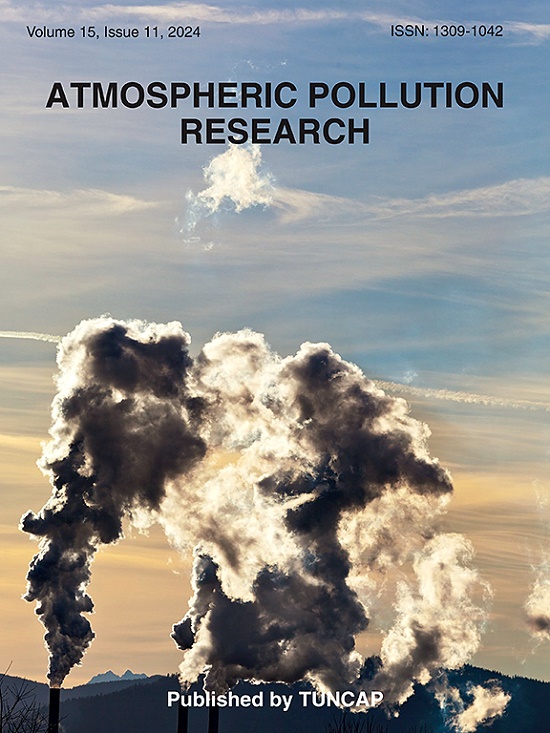利用空中平台研究欧洲3个城市大气边界层气象学对气候相关气体和挥发性有机化合物浓度的影响
IF 3.9
3区 环境科学与生态学
Q2 ENVIRONMENTAL SCIENCES
引用次数: 0
摘要
在欧盟Horizon2020 ICARUS项目框架下,一架美国国家航空航天局授予的轻型载人飞机配备了高科技科学仪器,用于对雅典、塞萨洛尼基和卢布尔雅那更大地区进行空中测绘。本研究旨在评价大气边界层(ABL)对上述城市城市和农村地区温室气体(ghg)和挥发性有机化合物(VOCs)浓度的影响。在各自区域同时进行了地面测量。空气样品由不锈钢波纹管压缩机加压到电抛光不锈钢罐中,并使用新型气相色谱系统进行分析。ABL混合高度(ΜΗ)的估算基于天气尺度大气环流和盛行背景风。结果发现,随着主要气象条件的变化,各观测区域对流层低层的浓度分布也不同。大气污染物浓度总体上随海拔高度的增加而降低。在一定的气象条件下,垂直混合加上水平输送会造成ABL顶部的高污染水平。工业化程度较低和逆风地区的污染物浓度较低,表明局地排放源对该地区的温室气体和VOCs水平有重要影响。然而,由于飞机覆盖的采样面积较大,上述梯度浓度相对较低。为模拟目前或未来相关工作中所研究的个案而进行的空气质素模拟活动,可减低运作成本,并可预测潜在影响。本文章由计算机程序翻译,如有差异,请以英文原文为准。

The effect of atmospheric boundary layer meteorology in climate-related gases and VOCs concentrations over 3 European cities using an aerial platform
In the frame of the EU Horizon2020 ICARUS project, a N.A.S.A Awarded Light Manned Aircraft equipped with high-tech scientific instrumentation was used to perform an aerial mapping over Athens, Thessaloniki and Ljubljana greater areas. This study aimed to evaluate the effect of Atmospheric Boundary Layer (ABL) on Green House Gases (GHGs) and Volatile Organic Compounds (VOCs) concentrations over urban and rural areas of the above cities. Simultaneous ground-based measurements were performed in the respective regions. Air samples were pressurized with a stainless-steel bellows compressor into electropolished stainless steel canisters and analyzed by the use of a novel gas chromatographic system. The estimation of the mixing height (ΜΗ) of the ABL was based on the synoptic scale atmospheric circulation and the prevailing background wind. It was found that the MH variation, following the prevailing meteorological conditions, results in different concentration profiles in the lower troposphere over the examined regions. The pollutants concentrations were generally decreasing with altitude in the ABL. Under certain meteorological conditions, vertical mixing plus horizontal transport can cause a high pollution level at the top of ABL. The pollutants concentrations were low over less industrialized and upwind regions, suggesting that local emission sources play significant role on the GHGs and VOCs levels over the regions. However, due to the large scale of sampling area that the aircraft covers the above gradients in concentrations are relative low. AQ modelling activities for simulating the cases studied in the current or any relative future work could reduce operating costs and allow projections of potential impacts.
求助全文
通过发布文献求助,成功后即可免费获取论文全文。
去求助
来源期刊

Atmospheric Pollution Research
ENVIRONMENTAL SCIENCES-
CiteScore
8.30
自引率
6.70%
发文量
256
审稿时长
36 days
期刊介绍:
Atmospheric Pollution Research (APR) is an international journal designed for the publication of articles on air pollution. Papers should present novel experimental results, theory and modeling of air pollution on local, regional, or global scales. Areas covered are research on inorganic, organic, and persistent organic air pollutants, air quality monitoring, air quality management, atmospheric dispersion and transport, air-surface (soil, water, and vegetation) exchange of pollutants, dry and wet deposition, indoor air quality, exposure assessment, health effects, satellite measurements, natural emissions, atmospheric chemistry, greenhouse gases, and effects on climate change.
 求助内容:
求助内容: 应助结果提醒方式:
应助结果提醒方式:


